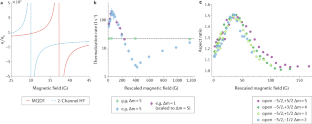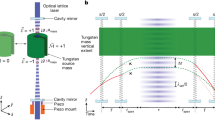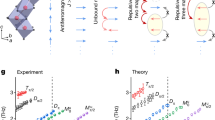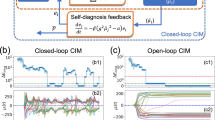Abstract
Ultracold alkaline-earth atoms are used in precision measurements and quantum simulation. Because of their unique atomic structure, they could enable the study of problems in quantum many-body systems, such as the simulation of synthetic gauge fields, Kondo and SU(N) physics. But to fully exploit this potential, the capability to tune the interatomic interaction to the strongly interacting regime is needed. Several theoretical proposals and experimental demonstrations have shown that both the spin-independent and spin-exchange interaction can be tuned to resonance in the alkaline-earth atoms. In this Perspective, we review these advances and discuss the opportunities brought by these interaction-control tools for future quantum simulation studies.
This is a preview of subscription content,access via your institution
Access options
Access Nature and 54 other Nature Portfolio journals
Get Nature+, our best-value online-access subscription
24,99 €/ 30 days
cancel any time
Subscribe to this journal
Receive 12 digital issues and online access to articles
92,52 € per year
only 7,71 € per issue
Buy this article
- Purchase on Springer Link
- Instant access to full article PDF
Prices may be subject to local taxes which are calculated during checkout



Similar content being viewed by others
Change history
26 May 2020
A Correction to this paper has been published:https://doi.org/10.1038/s42254-020-0194-4
References
Bloch, I., Dalibard, J. & Zwerger, W. Many-body physics with ultracold gases.Rev. Mod. Phys.80,885–964 (2008).
Bloch, I., Dalibard, J. & Nascimbène, S. Quantum simulations with ultracold quantum gases.Nat. Phys.8,267–276 (2012).
Gross, C. & Bloch, I. Quantum simulations with ultracold atoms in optical lattices.Science357,995–1001 (2017).
Goldman, N., Budich, J. C. & Zoller, P. Topological quantum matter with ultracold gases in optical lattices.Nat. Phys.12,639–645 (2016).
Takasu, Y. et al. Spin-singlet Bose–Einstein condensation of two-electron atoms.Phys. Rev. Lett.91,040404 (2003).
Fukuhara, T., Takasu, Y., Kumakura, M. & Takahashi, Y. Degenerate Fermi gases of ytterbium.Phys. Rev. Lett.98,030401 (2007).
Kraft, S., Vogt, F., Appel, O., Riehle, F. & Sterr, U. Bose–Einstein condensation of alkaline earth atoms:40Ca.Phys. Rev. Lett.103,130401 (2009).
Stellmer, S., Tey, M. K., Huang, B., Grimm, R. & Schreck, F. Bose–Einstein condensation of strontium.Phys. Rev. Lett.103,200401 (2009).
Martinez de Escobar, Y. N. et al. Bose–Einstein condensation of Sr 84.Phys. Rev. Lett.103,200402 (2009).
DeSalvo, B. J., Yan, M., Mickelson, P. G., Martinez de Escobar, Y. N. & Killian, T. C. Degenerate Fermi gas of Sr 87.Phys. Rev. Lett.105,030402 (2010).
Cazalilla, M. A. & Rey, A. M. Ultracold Fermi gases with emergent SU(N) symmetry.Rep. Prog. Phys.77,124401 (2014).
Daley, A. J. Quantum computing and quantum simulation with group-II atoms.Quantum Inf. Process.10,865–884 (2011).
Blagoev, K. B. & Komarovskii, V. A. Lifetimes of levels of neutral and singly ionized lanthanide atoms.At. Data Nucl. Data Tables56,1–40 (1994).
Bloom, B. J. et al. An optical lattice clock with accuracy and stability at the 10−18level.Nature506,71–75 (2014).
Ludlow, A. D., Boyd, M. M., Ye, J., Peik, E. & Schmidt, P. O. Optical atomic clocks.Rev. Mod. Phys.87,637–701 (2015).
Ushijima, I., Takamoto, M., Das, M., Ohkubo, T. & Katori, H. Cryogenic optical lattice clocks.Nat. Photonics9,185–189 (2015).
Nicholson, T. L. et al. Systematic evaluation of an atomic clock at 2\(\times \)10−18total uncertainty.Nat. Commun.6,6896 (2015).
Schioppo, M. et al. Ultra-stable optical clock with two cold-atom ensembles.Nat. Photonics11,48–52 (2017).
Campbell, S. L. et al. A Fermi-degenerate three-dimensional optical lattice clock.Science358,90–94 (2017).
Marti, G. E. et al. Imaging optical frequencies with 100 \(\mu \)Hz precision and 1.1 \(\mu \)m resolution.Phys. Rev. Lett.120,103201 (2018).
Wall, M. L. et al. Synthetic spin–orbit coupling in an optical lattice clock.Phys. Rev. Lett.116,035301 (2016).
Livi, L. F. et al. Synthetic dimensions and spin–orbit coupling with an optical clock transition.Phys. Rev. Lett.117,220401 (2016).
Kolkowitz, S. et al. Spin–orbit-coupled fermions in an optical lattice clock.Nature542,66–70 (2017).
Bromley, S. L. et al. Dynamics of interacting fermions under spin–orbit coupling in an optical lattice clock.Nat. Phys.14,399–404 (2018).
Goldman, N., Juzeliunas, G., Öhberg, P. & Speilman, I. B. Light-induced gauge fields for ultracold atoms.Rep. Prog. Phys.77,126401 (2014).
Zhai, H. Degenerate quantum gases with spin–orbit coupling: a review.Rep. Prog. Phys.78,026001 (2015).
Boyd, M. M. et al. Optical atomic coherence at the 1-second time scale.Science314,1430–1433 (2006).
Cazalilla, M. A., Ho, A. F. & Ueda, M. Ultracold gases of ytterbium: ferromagnetism and Mott states in an SU(6) Fermi system.New J. Phys.11,103033 (2009).
Gorshkov, A. V. et al. Two-orbital SU(N) magnetism with ultracold alkaline-earth atoms.Nat. Phys.6,289–295 (2010).
Taie, S. et al. Realization of a SU(2)\(\times \)SU(6) system of Fermions in a cold atomic gas.Phys. Rev. Lett.105,190401 (2010).
Stellmer, S., Grimm, R. & Schreck, F. Detection and manipulation of nuclear spin states in fermionic strontium.Phys. Rev. A84,043611 (2011).
Taie, S., Yamazaki, R., Sugawa, S. & Takahashi, Y. An SU(6) Mott insulator of an atomic Fermi gas realized by large-spin Pomeranchuk cooling.Nat. Phys.8,825–830 (2012).
Zhang, X. et al. Spectroscopic observation of SU(N)-symmetric interactions in Sr orbital magnetism.Science345,1467–1473 (2014).
Pagano, G. et al. A one-dimensional liquid of fermions with tunable spin.Nat. Phys.10,198–201 (2014).
Hofrichter, C. et al. Direct probing of the Mott crossover in the SU(N) Fermi–Hubbard Model.Phys. Rev. X6,021030 (2016).
Bishof, M. et al. Resolved atomic interaction sidebands in an optical clock transition.Phys. Rev. Lett.106,250801 (2011).
Martin, M. J. et al. A quantum many-body spin system in an optical lattice clock.Science341,632–636 (2013).
Clivati, C. et al. Measuring absolute frequencies beyond the GPS limit via long-haul optical frequency dissemination.Optics Express24,11865–11875 (2016).
Franchi, L. et al. State-dependent interactions in ultracold174Yb probed by optical clock spectroscopy.N. J. Phys.19,103037 (2017).
Goban, A. et al. Emergence of multi-body interactions in a fermionic lattice clock.Nature563,369–373 (2018).
Köhler, T., Góral, K. & Julienne, P. S. Production of cold molecules via magnetically tunable Feshbach resonances.Rev. Mod. Phys.78,1311–1361 (2006).
Chin, C., Grimm, R., Julienne, P. S. & Tiesinga, E. Feshbach resonances in ultracold gases.Rev. Mod. Phys.82,1225–1285 (2010).
Giorgini, S., Pitaevskii, L. P. & Stringari, S. Theory of ultracold atomic Fermi gases.Rev. Mod. Phys.80,1215–1274 (2008).
Strinati, G. C., Pieri, P., Roepke, G., Schuck, P. & Urban, M. The BCS–BEC crossover: from ultra-cold Fermi gases to nuclear systems.Phys. Rep.738,1–76 (2018).
Olshanii, M. Atomic scattering in the presence of an external confinement and a gas of impenetrable bosons.Phys. Rev. Lett.81,938 (1998).
Zhang, R., Cheng, Y., Zhai, H. & Zhang, P. Orbital Feshbach resonance in alkali-earth atoms.Phys. Rev. Lett.115,135301 (2015).
Höfer, M. et al. Observation of an orbital interaction-induced Feshbach resonance in173Yb.Phys. Rev. Lett.115,265302 (2015).
Pagano, G. et al. Strongly interacting gas of two-electron fermions at an orbital Feshbach resonance.Phys. Rev. Lett.115,265301 (2015).
Oppong, N. D. et al. Observation of coherent multiorbital polarons in a two-dimensional Fermi gas.Phys. Rev. Lett.122,193604 (2019).
Zhang, R. et al. Kondo effect in alkaline-earth-metal atomic gases with confinement-induced resonances.Phys. Rev. A93,043601 (2016).
Cheng, Y., Zhang, R., Zhang, P. & Zhai, H. Enhancing Kondo coupling in alkaline-earth-metal atomic gases with confinement-induced resonances in mixed dimensions.Phys. Rev. A96,063605 (2017).
Riegger, L. et al. Localized magnetic moments with tunable spin exchange in a gas of ultracold fermions.Phys. Rev. Lett.120,143601 (2018).
Boyd, M. M. et al. Nuclear spin effects in optical lattice clocks.Phys. Rev. A76,022510 (2007).
Cheng, Y., Zhang, R. & Zhang, P. Quantum defect theory for the orbital Feshbach resonance.Phys. Rev. A95,013624 (2017).
Regal, C. A., Ticknor, C., Bohn, J. L. & Jin, D. S. Creation of ultracold molecules from a Fermi gas of atoms.Nature424,47–59 (2003).
O’Hara, K. M., Hemmer, S. L., Gehm, M. E., Granade, S. R. & Thomas, J. E. Observation of a strongly interacting degenerate Fermi gas of atoms.Science298,2179–2182 (2002).
Scazza, F. et al. Observation of two-orbital spin-exchange interactions with ultracold SU(N)-symmetric fermions.Nat. Phys.10,779–784 (2014). CorrigendumNat. Phys.11,514 (2015).
Cappellini, G. et al. Direct observation of coherent interorbital spin-exchange dynamics.Phys. Rev. Lett.113,120402 (2014). ErratumPhys. Rev. Lett.114,239903 (2015).
Barber, Z. W. et al. Optical lattice induced light shifts in an Yb atomic clock.Phys. Rev. Lett.100,103002 (2008).
Dzuba, V. A. & Derevianko, A. Dynamic polarizabilities and related properties of clock states of the ytterbium atom.J. Phys. B43,074011 (2010).
Hewson, A. C.The Kondo Problem to Heavy Fermions(Cambridge Univ. Press, 1993).
Zhang, R. & Zhang, P. Control of spin-exchange interaction between alkali-earth-metal atoms via confinement-induced resonances in a quasi-(1.0)-dimensional system.Phys. Rev. A98,043627 (2018).
Zhang, R. & Zhang, P. Tight-binding Kondo model and spin-exchange collision rate of alkaline-earth atoms in a mixed-dimensional optical lattice.Phys. Rev. A101,013636 (2020).
Ji, Q., Zhang, R., Zhang, X. & Zhang, W. Confinement-induced resonance of alkaline-earth-metal-like atoms in anisotropic quasi-one-dimensional traps.Phys. Rev. A98,053613 (2018).
Xu, J. et al. Reaching a Fermi-superfluid state near an orbital Feshbach resonance.Phys. Rev. A94,033609 (2016).
Iskin, M. Two-band superfluidity and intrinsic Josephson effect in alkaline-earth-metal Fermi gases across an orbital Feshbach resonance.Phys. Rev. A94,011604 (2016).
Iskin, M. Trapped173Yb Fermi gas across an orbital Feshbach resonance.Phys. Rev. A95,013618 (2017).
Mondal, S., Inotani, D. & Ohashi, Y. Photoemission spectrum in the BCS–BEC crossover regime of a rare-earth Fermi gas with an orbital Feshbach resonance.J. Phys. Soc. Jpn87,094301 (2018).
Mondal, S., Inotani, D. & Ohashi, Y. Single-particle excitations and strong coupling effects in the BCS–BEC crossover regime of a rare-earth Fermi gas with an orbital Feshbach resonance.J. Phys. Soc. Jpn87,084302 (2018).
Mondal, S., Inotani, D. & Ohashi, Y. Closed-channel contribution in the BCS–BEC crossover regime of an ultracold Fermi gas with an orbital Feshbach resonance.J. Phys. Conf. Ser.969,012017 (2018).
Klimin, S. N., Tempere, J. & Milošević, M. V. Diversified vortex phase diagram for a rotating trapped two-band Fermi gas in the BCS–BEC crossover.New J. Phys.20,025010 (2018).
Laird, E. K., Shi, Z.-Y., Parish, M. M. & Levinsen, J. Frustrated orbital Feshbach resonances in a Fermi gas.Phys. Rev. A101,022707 (2020).
He, L., Wang, J., Peng, S.-G., Liu, X.-J. & Hu, H. Strongly correlated Fermi superfluid near an orbital Feshbach resonance: stability, equation of state, and Leggett mode.Phys. Rev. A94,043624 (2016).
Zhang, Y.-C., Ding, S. & Zhang, S. Collective modes in a two-band superfluid of ultracold alkaline-earth-metal atoms close to an orbital Feshbach resonance.Phys. Rev. A95,041603 (2017).
Zhang, H., Badshah, F., Basit, A. & Ge, G.-Q. Fermi gas of orbital Feshbach resonance in synthetic 1D.1 dimensional optical lattice.Laser Phys. Lett.15,115501 (2018).
Deng, T.-S., Zhang, W. & Yi, W. Tuning Feshbach resonances in cold atomic gases with interchannel coupling.Phys. Rev. A96,050701(R) (2017).
Wang, S., Pan, J.-S., Cui, X., Zhang, W. & Yi, W. Topological Fulde–Ferrell states in alkaline-earth-metal-like atoms near an orbital Feshbach resonance.Phys. Rev. A95,043634 (2017).
Zhou, X., Pan, J.-S., Yi, W., Chen, G. & Jia, S. Interaction-induced exotic vortex states in an optical lattice clock with spin–orbit coupling.Phys. Rev. A96,023627 (2017).
Zhou, X. et al. Symmetry-protected topological states for interacting fermions in alkaline-earth-like atoms.Phys. Rev. Lett.119,185701 (2017).
Zou, P., He, L., Liu, X.-J. & Hu, H. Strongly interacting Sarma superfluid near orbital Feshbach resonances.Phys. Rev. A97,043616 (2018).
Cappellini, G. et al. Coherent manipulation of orbital Feshbach molecules of two-electron atoms.Phys. Rev. X9,011028 (2019).
Qi, X. L. & Zhang, S. C. Topological insulators and superconductors.Rev. Mod. Phys.83,1057–1110 (2011).
Cui, X., Lian, B., Ho, T.-L., Lev, B. L. & Zhai, H. Synthetic gauge field with highly magnetic lanthanide atoms.Phys. Rev. A88,011601(R) (2013).
Burdick, N. Q., Tang, Y. & Lev, B. L. Long-lived spin–orbit-coupled degenerate dipolar Fermi gas.Phys. Rev. X6,031022 (2016).
Mancini, M. et al. Observation of chiral edge states with neutral fermions in synthetic Hall ribbons.Science349,1510–1513 (2015).
Song, S. et al. Spin–orbit-coupled two-electron Fermi gases of ytterbium atoms.Phys. Rev. A94,061604(R) (2016).
Song, S. et al. Observation of symmetry-protected topological band with ultracold fermions.Sci. Adv.4,4748 (2018).
Song, S. et al. Observation of nodal-line semimetal with ultracold fermions in an optical lattice.Nat. Phys.15,911–916 (2019).
Chevy, F. Universal phase diagram of a strongly interacting Fermi gas with unbalanced spin populations.Phys. Rev. A74,063628 (2006).
Cui, X. & Zhai, H. Stability of a fully magnetized ferromagnetic state in repulsively interacting ultracold Fermi gases.Phys. Rev. A81,041602(R) (2010).
Massignan, P., Zaccanti, M. & Bruun, G. M. Polarons, dressed molecules, and itinerant ferromagnetism in ultracold Fermi gases.Rep. Prog. Phys.77,034401 (2014).
Chen, J.-G., Deng, T.-S., Yi, W. & Zhang, W. Polarons and molecules in a Fermi gas with orbital Feshbach resonance.Phys. Rev. A94,053627 (2016).
Xu, J. & Qi, R. Polaronic and dressed molecular states in orbital Feshbach resonances.Eur. Phys. J. D72,65 (2018).
Chen, J.-G., Shi, Y.-R., Zhang, X. & Zhang, W. Polarons in alkaline-earth-like atoms with multiple background Fermi surfaces.Front. Phys.13,136702 (2018).
Deng, T.-S. et al. Repulsive polarons in alkaline-earth-metal-like atoms across an orbital Feshbach resonance.Phys. Rev. A97,013635 (2018).
Falco, G. M., Duine, R. A. & Stoof, H. T. C. Molecular Kondo resonance in atomic Fermi gases.Phys. Rev. Lett.92,140402 (2004).
Duan, L.-M. Controlling ultracold atoms in multi-band optical lattices for simulation of Kondo physics.Europhys. Lett.67,721–727 (2004).
Foss-Feig, M., Hermele, M., Gurarie, V. & Rey, A. M. Heavy fermions in an optical lattice.Phys. Rev. A82,053624 (2010).
Foss-Feig, M., Hermele, M. & Rey, A. M. Probing the Kondo lattice model with alkaline-earth-metal atoms.Phys. Rev. A81,051603(R) (2010).
Carmi, A., Oreg, Y. & Berkooz, M. Realization of the SU(N) Kondo effect in a strong magnetic field.Phys. Rev. Lett.106,106401 (2011).
Bauer, J., Salomon, C. & Demler, E. Realizing a Kondo-correlated state with ultracold atoms.Phys. Rev. Lett.111,215304 (2013).
Nishida, Y. SU(3) orbital Kondo effect with ultracold atoms.Phys. Rev. Lett.111,135301 (2013).
Nakagawa, M. & Kawakami, N. Laser-induced Kondo effect in ultracold alkaline-earth fermions.Phys. Rev. Lett.115,165303 (2015).
Isaev, L. & Rey, A. M. Heavy-Fermion valence-bond liquids in ultracold atoms: cooperation of the Kondo effect and geometric frustration.Phys. Rev. Lett.115,165302 (2015).
Kuzmenko, I., Kuzmenko, T., Avishai, Y. & Kikoin, K. Model for overscreened Kondo effect in ultracold Fermi gas.Phys. Rev. B91,165131 (2015).
Isaev, L., Schachenmayer, J. & Rey, A. M. Spin-orbit-coupled correlated metal phase in Kondo lattices: an implementation with alkaline-earth atoms.Phys. Rev. Lett.117,135302 (2016).
Kuzmenko, I., Kuzmenko, T., Avishai, Y. & Jo, G.-B. Coqblin–Schrieffer model for an ultracold gas of ytterbium atoms with metastable state.Phys. Rev. B93,115143 (2016).
Kuzmenko, I., Kuzmenko, T., Avishai, Y. & Jo, G.-B. Multipolar Kondo effect in a\({}^{1}{S}_{0}{-}^{3}{P}_{0}\)mixture of\({}^{1}{S}_{0}{-}^{3}{P}_{0}\)Yb atoms.Phys. Rev. B97,075124 (2018).
Nakagawa, M., Kawakami, N. & Ueda, M. Non-Hermitian Kondo effect in ultracold alkaline-earth atoms.Phys. Rev. Lett.121,203001 (2018).
Kanász-Nagy, M. et al. Exploring the anisotropic Kondo model in and out of equilibrium with alkaline-earth atoms.Phys. Rev. B97,155156 (2018).
Ashida, Y., Shi, T., Banuls, M. C., Cirac, J. I. & Demler, E. Solving quantum impurity problems in and out of equilibrium with the variational approach.Phys. Rev. Lett.121,026805 (2018).
Wenz, A. N. et al. From few to many: observing the formation of a Fermi sea one atom at a time.Science342,457–460 (2013).
Bergeman, T., Moore, M. G. & Olshanii, M. Atom–atom scattering under cylindrical harmonic confinement: numerical and analytic studies of the confinement induced resonance.Phys. Rev. Lett.91,163201 (2003).
Acknowledgements
This work is supported by the Ministery of Science and Technology (grant nos. 2018YFA0307601 (R.Z.), 2018YFA0306502 (P.Z.), 2016YFA0301600 (H.Z.)) and the National Natural Science Foundation of China (grant nos. 11804268 (R.Z.), 11434011 (P.Z.), 11674393 (P.Z.) and 11734010 (H.Z.)). P.Z. is also supported by the Research Funds of Renmin University of China (Grant No. 16XNLQ03). H.Z. is also supported by the Beijing Outstanding Young Scholar Program.
Author information
Authors and Affiliations
Contributions
The authors contributed equally to all aspects of the article.
Corresponding author
Ethics declarations
Competing interests
The authors declare no competing interests.
Additional information
Peer review information
Nature Reviews Physicsthanks the anonymous reviewers for their contribution to the peer review of this work.
Publisher’s note
Springer Nature remains neutral with regard to jurisdictional claims in published maps and institutional affiliations.
Rights and permissions
About this article
Cite this article
Zhang, R., Cheng, Y., Zhang, P.et al.Controlling the interaction of ultracold alkaline-earth atoms. Nat Rev Phys2,213–220 (2020). https://doi.org/10.1038/s42254-020-0157-9
Accepted:
Published:
Issue Date:
DOI:https://doi.org/10.1038/s42254-020-0157-9



